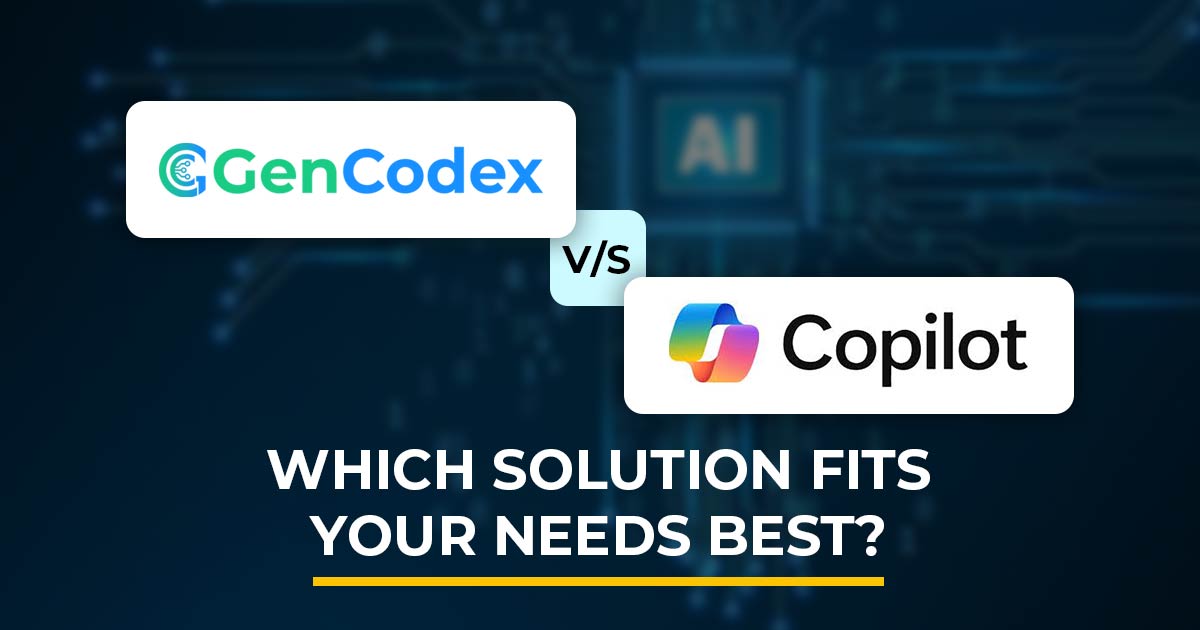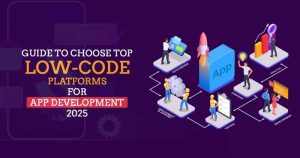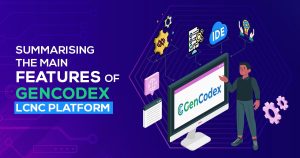Table of Contents
In the evolving world of software development, platforms like GenCodex and Microsoft Copilot have emerged as game-changers. They aim to simplify application development by reducing the need for extensive coding. Despite their shared purpose, these platforms differ significantly in features, customisation options, and usability. Let’s explore how GenCodex and Microsoft Copilot stack up against each other.
GenCodex: AI Based Low-code/No-code Platform
GenCodex is an intuitive platform designed to make application development accessible to everyone, even those without technical expertise. It emphasizes speed and simplicity, allowing users to transform ideas into functional and scalable applications with ease.
The platform’s focus on automation and flexibility enables users to customize their applications without dealing with complex coding. GenCodex combines user-friendly design, AI-powered tools, and seamless third-party integrations to create a powerful development experience.
A Comparison of key Features in Microsoft Copilot vs GenCodex:
Both tools use artificial intelligence, but they serve different purposes. GenCodex and Microsoft Copilot are designed to help them work closely with developer tools, making it easier for programmers to enhance their work.This discussion focuses on the main differences between Microsoft Copilot and GenCodex, highlighting what makes each of them special and how they can be useful.
Automation and AI Assistance
GenCodex stands out for its use of smart technology to help developers create applications. It has built-in AI tools that assist users by simplifying tasks like writing code, fixing errors, and optimizing system performance. This makes it a great option for teams that may not have a lot of technical skills since it reduces the amount of manual work needed to develop and launch new applications.
On the other hand, Microsoft Copalite also offers some automation features, especially through its integration with tools like Power Automate. However, it doesn’t have the same level of intelligent assistance as GenCodex, focusing more on streamlining business tasks with pre-made processes.
Customizability
GenCodex provides unmatched flexibility, enabling users to design tailored applications with minimal coding. It supports widely-used technologies like Java and Angular, offering developers the option to dig deeper into customization when needed.
Microsoft Copilot is designed for convenience within the Microsoft ecosystem. While its tools integrate seamlessly with Azure and Office 365, customization options are tied to these products. Businesses looking for cross-platform adaptability may find its approach limiting.
User Interface and Experience
GenCodex prioritizes ease of use, offering an intuitive interface with drag-and-drop features, pre-built templates, and AI-driven suggestions. It’s particularly appealing to non-technical users who want to create professional applications quickly.
Microsoft Copilot integrates seamlessly into the familiar Microsoft environment. Its interface aligns with tools like Excel and SharePoint, making it comfortable for businesses already relying on Microsoft products. However, the absence of robust AI guidance can make it less approachable for first-time users.
Integration and Connectivity
One of GenCodex’s strengths is its ability to integrate with a wide range of third-party tools, databases, and applications. This flexibility makes it a great choice for businesses needing diverse connectivity options.
Conversely, Microsoft Copilot excels within the Microsoft ecosystem. It’s optimized for integration with Azure, Power Automate, and other Microsoft tools. However, its reliance on Microsoft-centric services can be restrictive for organizations that depend on non-Microsoft solutions.
Deployment and Growth Potential
GenCodex supports multiple deployment methods, including cloud-based, on-premises, and hybrid models. It ensures scalability by accommodating growing user demands, making it suitable for businesses of all sizes.
Microsoft Copilot is best suited for Azure users, offering seamless deployment and scalability within the Microsoft cloud framework. While this is advantageous for businesses entrenched in the Microsoft ecosystem, it lacks the deployment flexibility offered by GenCodex.
Cost and Value
GenCodex offers scalable pricing plans that cater to varying business needs. Its affordability and flexible subscription options make it a cost-effective solution for organizations seeking custom features and AI-powered support.
Microsoft Copilot is often bundled with other Microsoft services, making it a valuable choice for companies already subscribed to Office 365 or Azure. For such organizations, Copilot’s integration and simplicity provide a strong return on investment.
Which Should You Choose?
The ideal platform depends on your specific needs:
Choose GenCodex if your priority is flexibility, AI-driven automation, and broad integration capabilities. It’s a versatile platform for businesses looking to create unique, scalable solutions.
Choose Microsoft Copilot if your organization is deeply integrated into the Microsoft ecosystem. Its compatibility with Azure and other Microsoft services makes it a convenient choice for businesses prioritizing ease of use within a familiar framework.
Conclusion
Both GenCodex and Microsoft Copilot simplify application development, but their approaches cater to different audiences. GenCodex focuses on flexibility, customization, and intelligent automation, making it ideal for businesses seeking innovative solutions. In contrast, Microsoft Copilot thrives within its ecosystem, offering a streamlined experience for organizations already invested in Microsoft tools.
By understanding your organization’s priorities, existing technologies, and long-term goals, you can choose the platform that aligns best with your needs.




